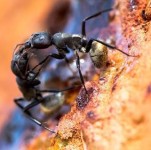By Multimedia On this episode of ID the Future, we listen in on a a few minutes from a lecture given by CSC Senior Fellow Michael Denton. We’ve all heard of the importance of photosynthesis as an oxygen creating process. In this segment, Denton explains the “remarkable set of coincidences” which makes the creation of oxygen through photosynthesis possible. From the specific energy of visible light to the unique properties of water, this degree of improbability screams DESIGN. Your browser does not support playing Audio, please upgrade your browser or find our podcast on podOmatic Download Episode For more on [More]
By Multimedia On this episode of ID the Future, Casey Luskin interviews Captain Dave Anderson, filmmaker and owner of Capt. Dave’s Dolphin and Whale Safari, who was involved in the production of Illustra Media’s new documentary, Living Waters: Intelligent Design in the Oceans of the Earth. Anderson shares about drone filming, whale disentanglement, and the importance of nature documentaries that explore design. Living Waters is now out on DVD. Buy it today! Your browser does not support playing Audio, please upgrade your browser or find our podcast on podOmatic Download Episode …read more Read more here: id the future
By Creation Moments Here at Creation Moments we have mentioned a few examples of fossils that, without argument, were formed recently. We have been trying to show that when you see a fossil or hear the word, you should not automatically think millions of years. In an attempt to maintain the illusion that fossils automatically must be millions of years old, evolutionists dismiss the examples of young fossils as freaks of nature. However, there are many examples of recent fossils. read more …read more Read more here: Creation Moments
By Creation Moments Evolutionists often claim that evolution can produce living things that look as if they are designed. This is their way of answering arguments that things that look designed don’t need a Designer. However, in January of 2000, a paleontologist and an astronomer teamed up to publish a book that says that conditions on Earth are so unique, there is probably no other life like us in the universe. (We do need to keep in mind, however, that they write from an evolutionary perspective.) read more …read more Read more here: Creation Moments
By Creation Moments On recent Creation Moments programs we have talked about several evidences that strongly suggest contact between Europe and the New World before Columbus. Some evidence even suggests that knowledge of the New World was common before the Dark Ages. Now, mainstream science has concluded that the Romans made it nearly as far as Mexico City by the second century A.D. read more …read more Read more here: Creation Moments
By Creation Moments Charles Darwin recognized that ants challenged his theory of natural selection. He even mentioned it in his Origin of Species. He even asked how the situation with the lowly ant could ever be reconciled with his theory. He never did come up with an answer, and neither have modern evolutionists. read more …read more Read more here: Creation Moments
By radio@answersingenesis.org (Steve Ham) …read more Read more here: Answers Conversation
By radio@answersingenesis.org (Steve Ham) …read more Read more here: Answers Conversation
By radio@answersingenesis.org (Steve Ham) …read more Read more here: Answers Conversation
By Creation Moments If you own a car, you know that it has an engine, doors and, of course, wheels. There are some engineering solutions to transportation problems that are clearly better than others, and no matter who makes the car, designers eventually arrive at the same solutions because they work best. read more …read more Read more here: Creation Moments
“Here is a link to part 1” Admin By Multimedia On this second episode of ID the Future, Casey Luskin interviews Dr. Richard Sternberg, evolutionary biologist and CSC Senior Fellow, whose discussion of whale origins is featured in Illustra Media’s new documentary, Living Waters: Intelligent Design in the Oceans of the Earth. Sternberg critiques conventional accounts of whale evolution, noting that neither natural selection or neutral drift cannot explain the transition between a land mammal and a fully aquatic whale. Standard evolutionary models would either require very large breeding population sizes (greater than that of any species of mammals) or [More]
By Creation Moments Warm-blooded creatures need to be able to vent excess heat or they begin to suffer heatstroke. One of the ways in which warm-blooded animals do this is through the nasal cavities. As they breathe, the air passes through sheets of mucous membranes that are designed to increase the surface area over which the air passes. These membranes have a rich blood supply. read more …read more Read more here: Creation Moments
“Here is a link to part 2” Admin By Multimedia In this first episode of ID the Future, Casey Luskin interviews Dr. Richard Sternberg, evolutionary biologist and CSC Senior Fellow, whose discussion of whale origins is featured in Illustra Media’s documentary, Living Waters: Intelligent Design in the Oceans of the Earth. Sternberg critiques whale evolution, noting that the timespan is too short for the bodyplan modifications needed to transition from a land mammal to a whale. Purchase Living Waters today! Your browser does not support playing Audio, please upgrade your browser or find our podcast on podOmatic Download Episode …read [More]
By Multimedia This episode of ID the Future features part of a lecture given by Biologic Institute scientist Doug Axe on his research on the molecule lignin. Lignin provides a paradoxical case for the Darwinian method of evolution, but fits perfectly into a design oriented scientific paradigm. Thirty percent of non-fossil organic carbon on the planet is lignin, so in a Darwinian world, something should have developed the ability to consume lignin–but it hasn’t. Lignin binds together and protects plant cellulose, which is vital to all types of large plant life; “The peculiar properties of lignin therefore make perfect sense [More]
By Creation Moments You may remember the “ice man” discovered in a glacier in the Alps in 1991. His frozen body had been preserved in the ice for thousands of years. Even his hair, beard and skin were largely intact. While there is some debate about when he lived, he is easily dated, in the biblical framework, to within several centuries after the Flood. read more …read more Read more here: Creation Moments
By Creation Moments Researchers at Purdue University are demonstrating that parrots are capable of intelligent communication. Their carefully designed experiments have convinced even skeptics that the two parrots under study are not just giving conditioned responses. Their results are challenging the accepted scientific knowledge about animal intelligence and the evolutionary claim that intelligence is one of the traits that separate us from animals. read more …read more Read more here: Creation Moments
By Creation Moments Did you know that radiocarbon dating may offer supporting evidence for Noah’s Flood? Many think that carbon dating provides evidence that the Earth is millions of years old, but this is not true. Radiocarbon dating can only reliably date things that are less than 3,000 years old. read more …read more Read more here: Creation Moments
By Creation Moments The Bible tells us that at the beginning of the Israelites’ 430-year stay in Egypt, they were well respected for Joseph’s sake. Later, when the Egyptian leadership forgot how Joseph saved Egypt, it began making their lives difficult. read more …read more Read more here: Creation Moments
By Multimedia On this episode of ID the Future, Casey Luskin discusses the Next Generations Science Standards (NGSS). The attempt to promote pro-Darwin science standards will diminish local control over what students learn. In Star Trek, the scientifically advanced race of Vulcans lives by the motto ‘infinite diversity and infinite combinations’. Their formula for scientific diversity makes sense as science advances by challenging old ideas and encouraging people to test new ones. Right now, public school education seems intent on adopting the opposite philosophy. Your browser does not support playing Audio, please upgrade your browser or find our podcast …read [More]
By Creation Moments A misunderstanding of some of the history recorded in Genesis has led some people to conclude that we are repeating the sins committed at the Tower of Babel. After all, we build huge cities and incredibly high skyscrapers. English is now virtually a universal language, and the Internet has led to the international pooling of knowledge. read more …read more Read more here: Creation Moments
By Creation Moments Modern evolutionists often give us the impression that evolution was accepted by the scientific community of Darwin’s day. But the scientists of Darwin’s day didn’t hear his theory, slap themselves on the forehead, and say, “Of course!” In fact, some of the most influential scientists of the day were hostile to Darwinian evolution. read more …read more Read more here: Creation Moments
By Creation Moments Honey has always been a popular food. For thousands of years it was a symbol of prosperity. Perhaps honey’s continuing appeal is one of the reasons there is so much research on honeybees. A research team has released their findings that explain how honeybees learn how to navigate. Another team has released information showing how bees know how far they have traveled. read more …read more Read more here: Creation Moments
By Creation Moments Sometimes the Bible seems to offer unnecessary or even impossible details as it recounts a historical event. Take, for example, the Genesis account of Rachel’s death while giving birth to Benjamin. read more …read more Read more here: Creation Moments
By Creation Moments Scientists have long known that some ants communicate with one another using vibrations. They also know that these ants pick up vibrations through ears that are located in their knees. Ants in four subfamilies communicate using these vibrations. These ants tend to build nests with wood or dried pulp, which tend to carry the vibrations. Disturb a carpenter ant nest, and the vibrations will begin. read more …read more Read more here: Creation Moments
By Multimedia On this episode of ID the Future, listen in as Casey Luskin talks with Dr. Neil Steiner, an engineer who works on computer and engineering research with the Information Sciences Institute at University of Southern California. Dr. Steiner offers his expertise to give unique insight into the debate over intelligent design and evolution, comparing natural biological systems to human designed technology. Your browser does not support playing Audio, please upgrade your browser or find our podcast on podOmatic Download Episode …read more Read more here: id the future
By Multimedia On this episode of ID the Future, Casey Luskin talks with Dr. Cornelius Hunter — a Discovery Institute Fellow, adjunct professor, and author — about his website Darwin’s Predictions, which critically examines 22 fundamental predictions of evolutionary theory. In this fourth and final podcast of the series, Dr. Hunter discusses evolution’s failed prediction that competition should be greatest between neighbors. Your browser does not support playing Audio, please upgrade your browser or find our podcast on podOmatic Download Episode …read more Read more here: id the future
By Multimedia On this episode of ID the Future, Casey Luskin talks with Dr. Cornelius Hunter—a Discovery Institute Fellow, adjunct professor, and author—about his website Darwin’s Predictions, which critically examines 22 fundamental predictions of evolutionary theory. In this third podcast of the series, Dr. Hunter discusses how mutations are adaptive and features of James Shapiro’s natural genetic engineering model. Your browser does not support playing Audio, please upgrade your browser or find our podcast on podOmatic Download Episode …read more Read more here: id the future





















